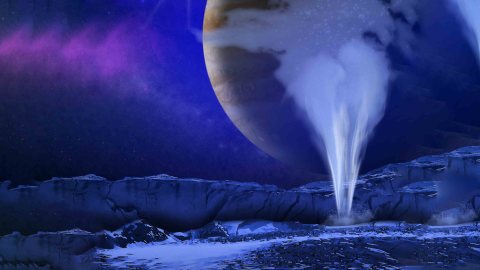NASA’s Big Reveal: Jupiter’s Moon Europa May Spout Water Plumes into Space

NASA has announced the likely presence of “plumes of water vapor” erupting from the surface of Europa, Jupiter’s icy moon. The frigid satellite has long been thought of as candidate for possible microbial life due to its vast subsurface ocean of water. While NASA does plan to send missions to Europa, as Bill Nye the Science Guy explains here, the recent discovery makes likely our ability to investigate Europa’s water without bombing or drilling through miles and miles of ice.
“If there are plumes emerging from Europa, it is significant because it means we may be able to explore that ocean for organic chemicals or even signs of life without having to drill through unknown miles of ice,” said William Sparksat the Space Telescope Science Institute in Baltimore, Maryland, which manages Hubble.
Europa is believed to have twice as much seawater as Earth beneath miles of frozen water. This makes Europa the most likely candidate for life in our solar system beyond Earth, i.e. alien life! Even before today’s announcement from NASA, Bill Nye explained how a future mission would search for life by taking advantage of Europa’s water geysers:
But before NASA scientists put forth a theory of what’s happening hundreds of millions of miles away, you can be sure they have some empirical data behind them. Today’s announcement is the result of two separate investigations into the surface of Europa:
2012
Using the Hubble Space telescope, a team of NASA astronomers observed a “faint aurora” resulting from the interaction of Jupiter and Europa’s magnetic fields. These measurements were consistent with the pattern of water molecules dissipating into space, and after considering several possible explanations, scientists landed on water vapor plumes emitting from the surface of Europa as the most plausible.
2015
A different team of NASA scientists used the same Hubble telescope to image Europa in ultraviolet lights as the moon transited across the face of Jupiter. The telescope is believed to have captured direct images of water vapor plumes rising 125 miles above the surface of Jupiter’s frozen moon.
—





